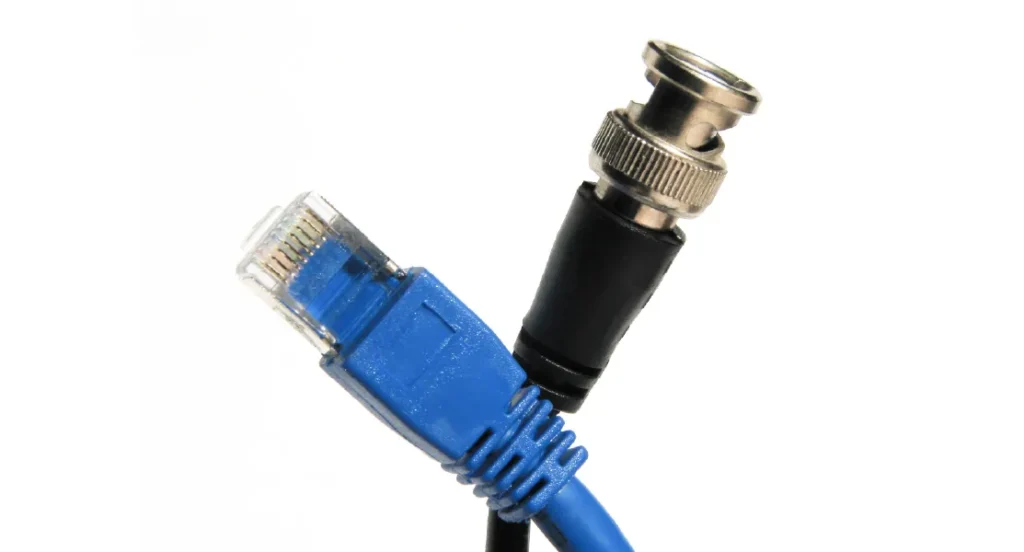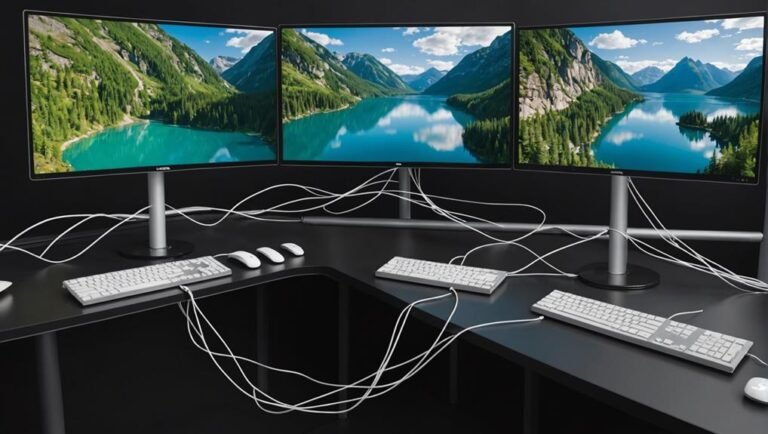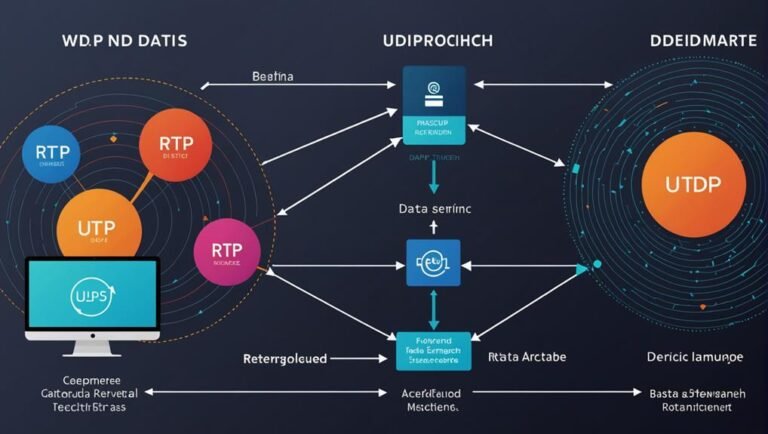Choosing between BNC and Ethernet cables depends on what you need. If simplicity and quick setup matter, Ethernet wins with its easy-to-use RJ45 connectors. For durability and interference resistance, BNC cables shine, especially in surveillance systems. Ethernet excels in data transfer speeds, reaching up to several gigabits per second, unlike BNC’s 10 Mbps limit. While BNC might be cheaper initially, Ethernet provides long-term cost efficiency and scalability. Ethernet also offers future-proofing, accommodating various applications. If you’re interested in installation methods, signal quality, and more, there’s plenty to explore next.
Installation Complexity
When it comes to installation complexity, you’ll find that BNC cables can be a bit more cumbersome to set up compared to Ethernet cables. BNC cables, often used in older video and radio frequency applications, require specific tools to attach connectors securely. The twist-and-lock mechanism on BNC connectors can be tricky, especially if you’re new to it. With Ethernet cables, it’s as simple as snapping the RJ45 connectors into place—no special tools or techniques needed.
Cable length is another factor that can complicate BNC cable installation. BNC cables typically come in pre-determined lengths, which might limit your flexibility. If you need a custom length, you’ll have to cut and terminate the cable yourself, adding another layer of complexity. Ethernet cables, on the other hand, are available in various lengths and custom options, making them easier to fit into your setup without much hassle.
Connector types further highlight the differences. BNC connectors require precise alignment and secure locking, whereas Ethernet connectors are designed for straightforward, tool-free installation. If you value efficiency and ease, Ethernet cables clearly offer a more streamlined installation process, letting you get back to what you love faster.

Signal Quality
Signal quality often becomes a crucial factor when choosing between BNC cables and Ethernet cables. You require a dependable connection that won’t hinder your ability to move around without concerns about connectivity issues. So, let’s explore how each type of cable compares in terms of signal interference and cable attenuation.
BNC cables are recognized for their resistance to signal interference. They utilize a coaxial design that shields the inner conductor, reducing disturbances from external signals. This makes BNC a reliable option for environments with significant electronic interference. However, BNC cables may experience cable attenuation, where the signal weakens over long distances. Signal boosters or repeaters may be necessary if you intend to use these cables over extended distances.
On the other hand, Ethernet cables, particularly shielded types like Cat6a or Cat7, provide excellent protection against signal interference. They are engineered to manage noise and crosstalk, ensuring a clearer signal. In terms of cable attenuation, Ethernet cables also deliver good performance, although they have limitations over very long distances. Ethernet cables can typically operate up to 100 meters without notable signal loss, making them a versatile choice for a variety of setups.
Ultimately, your decision depends on your specific requirements and surroundings.
Data Transfer Speed
When comparing BNC cables and Ethernet, data transfer speed is an important factor. You’ll want to examine speed comparison metrics and bandwidth capabilities to see which option meets your needs. Let’s break down how each type performs in these areas.
Speed Comparison Metrics
Comparing the data transfer speeds of BNC cables and Ethernet reveals significant differences that can impact network performance. When you’re looking at speed variations and signal speed, it’s clear that Ethernet often outpaces BNC cables. Traditional BNC cables, primarily used in older television and CCTV systems, have limited data transfer rates. They’re typically capped at speeds that would seem sluggish by today’s standards, often around 10 Mbps.
On the other hand, modern Ethernet cables offer a much more dynamic range. With Cat5e, Cat6, and beyond, you can enjoy speeds from 100 Mbps to several gigabits per second. This makes Ethernet a go-to choice for anyone needing rapid and efficient data transfer. You won’t be held back by slow signal speed, allowing your data to flow freely and swiftly.
Ethernet’s superior speed metrics mean you can handle high-demand tasks like video streaming, online gaming, and large file transfers with ease. If freedom from lag and delays is what you crave, Ethernet cables clearly have the upper hand. Whether you’re setting up a home network or a business infrastructure, the speed advantages of Ethernet are hard to ignore.
Bandwidth Capabilities
While speed is an important factor, understanding the bandwidth capabilities of BNC and Ethernet cables further highlights their differences in data transfer efficiency. BNC cables typically operate within a lower frequency range, which limits their bandwidth. This makes them suitable for applications like CCTV systems but less ideal for high-speed data transfers. On the other hand, Ethernet cables, particularly Cat6 and above, offer notably higher bandwidth, making them better suited for internet and network communications.
Signal interference is another essential aspect to take into account. BNC cables, due to their coaxial design, can be more susceptible to signal interference, especially over longer distances. Ethernet cables, especially those with shielded twisted pairs, are designed to minimize this interference, ensuring a more stable and faster data transfer.
Here’s a quick comparison:
| Cable Type | Frequency Range | Typical Bandwidth |
|---|---|---|
| BNC | Up to 500 MHz | Up to 1 Gbps |
| Cat5e | Up to 100 MHz | Up to 1 Gbps |
| Cat6 | Up to 250 MHz | Up to 10 Gbps |
| Cat6a+ | Up to 500 MHz+ | Up to 10 Gbps+ |
Choosing between BNC and Ethernet comes down to what kind of data transfer speed and reliability you need. If you’re after freedom and efficiency in data communication, Ethernet cables are usually the better choice.
Use Cases
For different applications, BNC cables and Ethernet serve distinct purposes that cater to specific technical requirements. If you’re setting up surveillance systems, BNC cables might just be your best friend. They’ve been the traditional choice for closed-circuit television (CCTV) due to their ability to handle analog signals effectively. This makes them particularly reliable in transmitting video feeds without the latency that sometimes plagues digital setups. Plus, in many industrial applications, BNC cables shine because they’re robust and less susceptible to electromagnetic interference, ensuring a stable connection in environments with heavy machinery.
On the other hand, Ethernet cables are your go-to for most modern networking needs. They excel in delivering high-speed internet connections, making them perfect for both home and office use. Whether you’re streaming, gaming, or managing a smart home, Ethernet cables provide the speed and reliability that wireless connections often can’t match. In business settings, they’re essential for connecting computers, printers, servers, and other networked devices, ensuring seamless communication and data transfer.
Cost Comparison
When comparing costs, you’ll notice differences in initial setup expenses and long-term cost efficiency between BNC cables and Ethernet. BNC cables might have lower upfront costs, but Ethernet often proves more cost-effective over time due to its scalability and lower maintenance needs. Understanding these factors helps you make an informed decision for your specific requirements.
Initial Setup Expenses
How do the initial setup expenses of BNC cables compare to those of Ethernet cables? When considering cable length, BNC cables can be a bit cheaper per foot, but you have to factor in the cost of the BNC connectors and any necessary adapters. BNC connectors can add up quickly, especially if you’ve got a lot of devices to connect. On the other hand, Ethernet cables, specifically Cat5e or Cat6, are widely available and come in various lengths without a significant price hike.
Ethernet cables also use RJ45 connectors, which are generally more affordable and easier to work with. You won’t need specialized tools or knowledge to set these up, which can save you time and money. If you’re looking for a straightforward, cost-effective setup, Ethernet might be the way to go.
Ultimately, your choice depends on your specific needs and how much you value ease of installation versus upfront cost. BNC might be tempting if you have a shorter, more specialized setup, whereas Ethernet gives you the freedom to scale and adapt without breaking the bank. Either way, weigh these initial expenses carefully to make sure you’re making the best investment for your setup.
Long-term Cost Efficiency
While initial setup expenses are a consideration, long-term cost efficiency is equally important when comparing BNC cables to Ethernet cables. If you’re looking for a solution that minimizes future expenses, it’s essential to weigh both options carefully.
BNC cables often come with lower initial costs but can be more demanding over time due to higher maintenance requirements. They may require regular inspections and replacements, driving up long-term costs. On the other hand, Ethernet cables typically have lower maintenance needs, making them a more cost-effective option in the long run. You won’t have to worry about frequent checks or replacements, giving you more freedom to focus on other priorities.
Energy consumption is another factor to take into account. Ethernet cables, particularly those that support Power over Ethernet (PoE), can be more energy-efficient. They can power devices directly through the cable, reducing the need for additional power sources and cutting down on electricity costs. BNC cables don’t offer this capability, meaning you might end up spending more on energy over time.
Ultimately, if you’re seeking long-term cost efficiency with fewer headaches, Ethernet cables are likely the more attractive option.
Durability
Durability is an essential factor in choosing between BNC cables and Ethernet cables, as it directly impacts the longevity and reliability of your network setup. When it comes to durability testing, both types of cables have their strengths. BNC cables, with their robust construction, are particularly resistant to physical wear and tear. They’re designed to withstand harsh conditions, making them ideal for environments where cables might be exposed to rough handling or frequent movement. If you’re setting up in a place where durability is key, BNC cables won’t disappoint.
On the other hand, Ethernet cables are also built to last but offer a different kind of resilience. Modern Ethernet cables, especially those with sturdy shielding, can handle significant physical wear, including bending and pulling. They’ve been rigorously tested to make certain they can endure everyday use without degrading in performance. Plus, with various categories of Ethernet cables available, you can find one that matches your specific durability needs.
Future-Proofing
Apart from durability, it’s important to evaluate how well each cable type will adapt to future technological advancements. When considering BNC cables, you might find them a bit limiting. They’re great for specific applications like CCTV or broadcast video, but as technology evolves, their adaptability can be a concern. You could face compatibility concerns when integrating them with newer systems, potentially stifling your freedom to upgrade seamlessly.
On the other hand, Ethernet cables are designed with the future in mind. They support a wide range of applications, from simple home networks to complex enterprise setups. As technological advancements continue, Ethernet cables offer incredible flexibility. Newer standards like Cat6 and Cat7 ensure you’re not left behind as data speeds and network demands increase. Compatibility concerns are minimal because Ethernet is a universal standard in networking, making it easier to integrate new devices without worrying about outdated infrastructure.
In a world that’s constantly evolving, you want solutions that grow with you. Ethernet cables provide that peace of mind, adapting to your needs and allowing you to embrace new technologies without hesitation. If future-proofing is a priority, Ethernet is the way to go.
Frequently Asked Questions
Are BNC Cables Compatible With Modern Network Devices?
Imagine BNC cables as an old key; they don’t fit the locks of modern network devices well. Signal compatibility and device adaptability have evolved, making these cables less suited for today’s tech freedom seekers.
Can Ethernet Cables Be Used for Video Transmission?
Yes, you can use Ethernet cables for video transmission, but keep bandwidth limitations and signal quality in mind. You’ll enjoy the freedom of higher speeds and better reliability compared to older technologies.
How Do BNC and Ethernet Cables Fare in Terms of Weather Resistance?
When it comes to weather resistance, you’ll find BNC cables often have better connector durability and insulation quality. However, some Ethernet cables are also designed to withstand harsh conditions, so you don’t have to worry much either way.
Do BNC and Ethernet Cables Require Special Tools for Maintenance?
You’re wondering about maintenance costs and tool availability for these cables. BNC cables need special crimping tools, which can add to costs. Ethernet cables typically don’t require specialized tools, making maintenance cheaper and more accessible.
Are There Environmental Considerations When Choosing Between BNC and Ethernet Cables?
Just as Odysseus faced many obstacles, you’ll consider signal interference and cable durability. Ethernet’s less prone to interference, but BNC cables offer superior durability in harsh conditions. Choose wisely to guarantee lasting, reliable connections.



